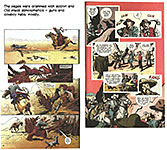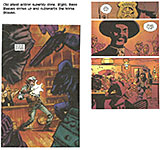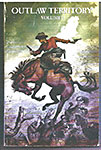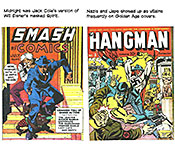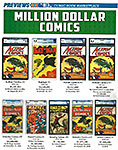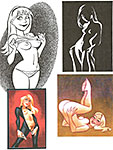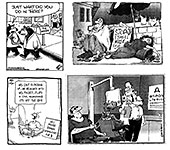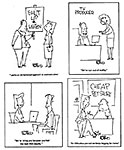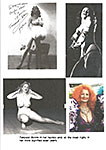 |
|||||||||||||||||||
Opus 417 (through May 5, 2021). News and reviews this time—so much and so many that we simply filled up to the brim, resulting in postponing our Editoon review until next time (which we plan to release in two weeks or less). Topics this time—a list of the 147 mass killings so far this year, editoons on the verdict in the Chauvin trial, Tarzan reaches the end of the vine, stereotyping and racism and cartoon shorthand, reviews of comicbook number ones (Ha Ha, Women of Marvel) and Ta-Nehisi Coates’ Captain America, Timm’s Big Tease and a fond farewell to Tempest Storm, dead at 93. Here’s what’s here, by department, in order (the longest entries are marked with an asterisk* a reader’s guide to help you decide where to spend your time)—:
NOUS R US Gun Control Again *147 Mass Killings So Far This Year
Police Shootings
*THE VERDICT In the George Floyd Murder Trial Leonard Pitts, Jr. Steve Sack Editoons on the Trial
KAL Wins OPC Award
TARZAN COMIC STRIP REACHES END OF THE VINE STEREOTYPING, RACISM AND CARTOON SHORTHAND And the Recent Anti-Asian Persecution Cover of The New Yorker
ANGOULEME 2021 CANCELLED PREVIEWS PIN-UPS
Trans
FUNNYBOOK FAN FARE Cojacaru the Skinner No.1 Daredevil Lately HaHa Nos.1-3 Women of Marvel No.1 Savage Dragon/Tawky Tiger *New Superman: Infinite Frontier (Nos.1027 - 1030) Ta-Nehisi Coates’ Captain America
TRUMPERIES Farewell
ACCRETION OF INTENTION DEPARTMENT Books In Need of Good Reviews Outlaw Territory, Vol.2 Action! Mystery! Thrills! Comic Book Covers of the Golden Age
RANCID RAVES GALLERY Northwest Airlines Logo—Excellent! Million Dollar Comics Supergirl and George Floyd Make the Covers
BOOK MARQUEE Short Review of— The Big Tease: A ‘Naughty and Nice’ Collection by Bruce Timm
BOTTOM LINERS Single Panel Gag Cartoons
Passin’ Through *Tempest Storm
QUOTE OF THE MONTH If Not of A Lifetime “Goddamn it, you’ve got to be kind.”—Kurt Vonnegut Our Motto: It takes all kinds. Live and let live. Wear glasses if you need ’em. But it’s hard to live by this axiom in the Age of Tea Baggers, so we’ve added another motto: Seven days without comics makes one weak. (You can’t have too many mottos.) And in the same spirit, here’s—: Chatter matters, so let’s keep talking about comics. AND—
“If we can imagine a better world, then we can make a better world.”
And our customary reminder: don’t forget to activate the “Bathroom Button” by clicking on the “print friendly version” so you can print off a copy of just this installment for reading later, at your leisure while enthroned. Without further adieu, then, here we go—:
NOUS R US Some of All the News That Gives Us Fits
GUN CONTROL AGAIN And Again and Again... IN OTHER WORDS, here we go again. Outrage and alarm. Some are outraged at the number of murders guns have helped commit every year; others are alarmed that some menacing government official is going to be authorized to take their guns away. To quote Nicholas Kristof in the New York Times: “More Americans have died from guns just since 1975—including suicides, murders, and accidents (more than 1.5 million all together)—than in all the wars in United States history, dating back to the Revolutionary War (about 1.4 million all told). No one is spared. In a typical year, more children from infancy through 4 years old are fatally shot in the U.S. (about 80) than police officers (about 50 or fewer). When Europeans lose their tempers, they punch someone; Americans pull out a handgun. Foreigners express road rage by cursing; a driver in North Carolina recently expressed his by firing shots into another car, killing a mother of six.” There were 600 mass shootings in 2020, compared to 417 in 2019. A “mass shooting” for the present purpose is one in which four or more people were killed or injured, excluding the shooter. And it continues: so far in 2021, we’ve had 147 mass killings as of April 16. Here’s CNN’s list of 45 mass killings in one month, April 15 to March 16—:
April 15: Indianapolis Eight people were killed and several others wounded in a mass shooting at an Indianapolis FedEx facility on Thursday night, Indianapolis Metropolitan Police Department spokeswoman Genae Cook said. A bloody weekend followed, reported The Week. It began in Omaha when a 16-year-old boy allegedly shot a 21-year-old man and wounded another person at a mall. Hours later, a passenger in an SUV opened fire on a group of mourners gathered for a vigil in Columbus, Ohio. That same night, a 12-year-old’s birthday party in LaPlace, La., ended in gunfire between feuding gangs. Next came a gunfight at a college bar in Kenosha, Wis., and the next day, in Austin, a former Travis County sheriff’s detective rammed his ex-wife’s car and unleashed a fusillade of shots that killed her, his step-daughter, and his step-daughter’s boyfriend.
April 15: Pensacola, Florida At least six people were injured at an Escambia County apartment complex, as reported by CNN affiliate WEAR-TV. No suspects are in custody. April 15: Washington, DC Four people were shot, including a teenage girl, Thursday in Northeast Washington, DC, affiliate WRC reported. April 13: Baltimore Police said a dice game turned violent when two shooters opened fire on a group, injuring four, according to CNN affiliate WJZ-TV. April 12: Chicago Four people were shot, one fatally, and a fifth person was hit by a car in a shooting early Monday on the Eisenhower Expressway, affiliate WMAQ reported. April 11: Wichita, Kansas One person was killed and three others injured in a shooting at a house party at an East Wichita Airbnb, as reported by CNN affiliate KWCH. April 11: Seattle A toddler and three other people were injured when suspects fired into a business parking lot, according to CNN affiliate KIRO 7. April 10: Memphis, Tennessee One person was killed and three others were injured, including a mother and child, after gunfire was exchanged in a Memphis neighborhood, according to CNN affiliate WHBQ. April 10: Koshkonong, Missouri One person was killed and three others injured in a shooting at a convenience store, according to CNN affiliate KY3. April 10: Waterbury, Connecticut Police responded to calls of a weapons complaint and found blood trails and four injured victims, reported CNN affiliate WFSB. April 10: Allendale, Michigan An incident outside a house party resulted in four people being shot and one critically injured, according to CNN affiliate WWMT. April 9: Fort Worth, Texas One person was killed and at least five others injured when people in two vehicles shot at each other on a Fort Worth, Texas, freeway Friday night, officials said. April 8: Bryan, Texas A gunman killed one person and wounded at least five others -- four of them critically -- at a cabinet manufacturer, police said. April 7: Rock Hill, South Carolina A former NFL player killed six people -- including a prominent doctor, his wife and their two young grandchildren -- before killing himself, authorities said. April 7: Milwaukee A 26-year-old man was charged with the shooting that killed two people and injured two others at a gas station, according to CNN affiliate WDJT. April 6: Detroit One person was killed and three others injured after gunfire erupted from a car, according to CNN affiliate WDIV. April 5: Baltimore Five victims were taken to a hospital with multiple gunshot wounds, Baltimore police said. April 4: Monroe, Louisiana Police responded to Bobo's Bar, where they found six victims with gunshot wounds, according to CNN affiliate KNOE. April 4: Birmingham, Alabama An argument between two groups of men devolved into more than 30 shots fired at a park on Easter -- killing a woman and wounding five other people, including four children, police said. April 4: Beaumont, Texas A man arrived at a home, threatening several people with a firearm before shooting four victims, according to Beaumont Police. April 3: Wilmington, North Carolina Three people were killed and four others injured in a mass shooting at a house party, according to CNN affiliate WECT. April 3: Tuscaloosa, Alabama Two men were arrested and charged with attempted murder after five people were injured during a shooting outside an Alabama bar, police said. April 3: Dallas In what police said was an apparent murder-suicide plot, 21-year-old and 19-year-old brothers made a pact to kill their parents, sister and grandmother, according to CNN affiliate KLTV. April 3: Quincy, Florida Seven people were injured by gunfire near a nightclub after a fight broke out into gunshots, according to CNN affiliate WCTV. March 31: Orange, California Four people, including a child, were killed and another person wounded in a mass shooting at an office complex in Orange, California, according to authorities. March 31: Washington, DC Five people were shot in Washington, the DC Police Department said. The incident started as a dispute and ended with two people dead and three injured. March 28: Cleveland Seven people were shot at a Cleveland nightclub, according to CNN affiliate WOIO. The victims, four men and three women, were all between 20 and 30 years old, and police believe several people fired inside the nightclub, the station reported. March 28: Chicago Four people in an SUV were shot on the I-57 expressway, according to CNN affiliate WLS. All were taken to hospitals in critical condition. March 28: Essex, Maryland A man fatally shot his parents before shooting three people at a convenience store, killing two of them, CNN affiliate WBOC reported, citing Baltimore County police. The suspect died by suicide. March 27: Chicago Four people were shot in Chicago's South Austin neighborhood, according to CNN affiliate WBBM. The victims, who included men ages 42, 53 and 64, were near a sidewalk when they were shot, the station reported. March 27: Yazoo City, Mississippi At least seven people were injured in a mass shooting at a nightclub, CNN affiliate WLBT reported. At least six people were shot and another person suffered a laceration, the station reported. March 27: River Grove, Illinois A shooting on a party bus left three people injured and one dead, according to CNN affiliate WLS. Police say the occupants of another vehicle fired at the bus while stopped at an intersection, the station reported. March 26: Virginia Beach, Virginia Three shootings in the city left eight people injured and two dead, according to the City of Virginia Beach. March 26: Chicago A gathering in Chicago's Wrightwood neighborhood turned into a mass shooting, according to CNN affiliate WLS. Two gunmen opened fire inside the gathering, wounding seven people and fatally shooting a 26-year-old man, the station reported. March 26: Norfolk, Virginia Police responded to a shooting that left four people wounded, CNN affiliate WTKR reported. The victims -- two 18-year-old men, a 17-year-old girl and a 21-year-old woman -- sustained non-life-threatening gunshot wounds. March 26: Memphis, Tennessee Five people were shot, the Memphis Police Department said on Twitter. Three victims were pronounced dead at the scene, two were taken to a hospital in critical condition, and one was in non-critical condition, the tweet said. Michael Tucker, the man identified as the suspect, was found dead in a motel in Nashville Thursday. Police spokesman Don Aaron said it is believed Tucker died of a self-inflicted gunshot wound. March 26: Philadelphia Outside of the Golf and Social Club, police say two suspects shot seven people, CNN affiliate WPVI reported. Video released by police shows two suspects approaching a gathering crowd and opening fire. March 23: Aliceville, Alabama A shooting reported at an Aliceville home left two people dead and two injured, according to CNN affiliate WVTM. March 23: Boulder, Colorado Ten people, including a Boulder police officer, were killed in a shooting at a King Soopers supermarket, according to police. March 20: Philadelphia One person was killed and another five were injured in a shooting at an illegal party, CNN affiliate KYW reported. "There were at least 150 people in there that fled and believed they had to flee for their lives," Philadelphia Police Commissioner Danielle Outlaw said. March 20: Dallas Eight people were shot, one fatally, by an unknown assailant, according to police. March 20: Houston Five people were shot after a disturbance inside a club, according to police. One was in critical condition after being shot in the neck, and the rest were in stable condition, according to CNN affiliate KPRC. March 18: Gresham, Oregon Four victims were taken to the hospital after a shooting in the city east of Portland, police said in an initial report. March 17: Stockton, California Five people who were preparing a vigil in Stockton, in California's Central Valley, were shot in a drive-by shooting, the San Joaquin Sheriff's Department said. None had life-threatening injuries. March 16: Atlanta Eight people, including six Asian women, were killed when a White gunman stormed three spas, police said.
And here are a few more—:
March 13: Indianapolis Four dead, including a 7-year-old child. February 2: Muskogee, Oklahoma Five children and a man killed; shot at home by a relative. January 24: Indianapolis Five found dead in a home. This city is getting a bad reputation: this is the third mass murder this year in Indianapolis. January 9: Evanston, Illinois Seven killed, including a 15-year-old girl in a “rampage.”
No matter. Thoughts and prayers are mustered at each mass killing. Nothing else. We’re at a standoff. But we know, now, that nothing will be done—nothing large enough, pervasive enough, to have any real, long-lasting effect. Guns are simply too deeply embedded in our culture. Our attitude about guns and their place in society is a matter of cultural conviction. Guns permeate our society. The only way to begin to achieve change would be to ban gun violence from all movies and all television shows. That’s how deeply our gun culture runs. And we know, contemplating movies and tv, how difficult—how impossible—it would be to change. The only thing left to do is what we’re doing. We bemoan gun violence whenever it happens. And that’s not entirely a negative result. Such bemoaning as we do creates, slowly over the years, the notion that guns are dangerous and ought to be regulated, just as driver’s licenses are. Over the years, outrage will slowly whittle away at the idea that guns are manhood, that guns are fun, that guns are rights that cannot, should not, be taken away. Or so we hope.
Policing with a Gun By Charles M. Blow, New York Times; April 18 Every year, the police shot and killed roughly 1,000 people. But, as the Washington Post points out, Black Americans are killed at a much higher rate than white Americans, and the data revealed that unarmed Black people account for about 40% of the unarmed Americans killed by the police, despite making up only about 13% of the American population. ... Tellingly, the racial disparity drops after sunset when it’s harder for an officer to see a driver’s face. “Driving while Black” is very much a thing. Our systems of law enforcement, criminal justice and communal consciousness have adjusted themselves to a banal barbarism. ... A society that treats this much Black death at the hands of the state as collateral damage in a just war on crime has no decorum to protect. That society is savage, concludes Blow. The police justify their militarization and armed-and-ready posture by correctly observing that they can be outgunned by a public with such easy access to guns, including military-style guns. ... Moreover (to add my two cents in), two aspects of a policeman’s training result in a mind-set for violence. Cops are trained to believe that every citizen they pull over may be an armed criminal, says The Week, so some cops approach stops with adrenalized fear and hair-trigger aggression. They are also taught that they must command in every encounter with citizenry; the slightest deviation from absolute and perfect obedience to their orders demands escalating insistence, with guns underscoring the need. Not all police shootings are unjustified, saith Peggy Noonan in the Wall Street Journal. And she cites the shooting of Ma’Khia Bryant, 16, in Columbus, Ohio. Bodycam video shows Bryant attacking another girl with a knife when the officer fired, yet there were immediate calls for the officer to be prosecuted. Had the cop not shot, Bryant may have killed someone. Still, killing a thousand of your fellow citizens every year sounds like a bit much. We must train police differently. Instead of asserting command control of a situation, cops should strive to calm the conflict inherent in a hostile confrontation. Don’t shoot; talk instead.
THE VERDICT I was a little troubled by the news coverage of the Chauvin verdict. It was as if the verdict were rendered on "race"—as if the verdict was that Chauvin was a racist. Chauvin may, indeed, be a racist. But he wasn't on trial for being a racist. He was on trial for killing a man. He probably didn't intend to kill George Floyd. But he did kill him, in a manner that showed a willful disregard for the life of another human being. After a while, though, I got over my troubled feeling that the verdict had been about race in America instead of about murder. It was about race in America. And it was also about murder. Then I looked up what Leonard Pitts, Jr. had to say on the matter; here it is—:
Real Justice Shouldn't Be This Difficult By Leonard Pitts Jr., on Apr 21, 2021 Pitts is one of the top half-dozen syndicated columnists who helps make sense of the world as it spins around us. I think he’s the best. Herewith, his reaction (as a Black man) to the Chauvin verdict—:
I sat there trying to remember how to breathe. I suspect I had that in common with people — particularly African-American people — all over the country. Didn’t we all hold our breath as we awaited the verdict in the trial of Derek Chauvin? Then that verdict was read. The former Minneapolis police officer was found guilty on all three counts in the death of George Floyd and was promptly handcuffed and led off to jail. As seen on television, people shouted and prayed, cranking their fists toward heaven. I just sat there, trying to remember how lungs are supposed to work. And thinking that justice — real justice — shouldn’t be this difficult. In a nation that was not broken along seams of race, a nation where you could trust the police to actually protect and serve no matter the color of your skin, Chauvin’s conviction would have been a foregone conclusion. But in this nation, it was anything but. That’s why I forgot to breathe. And why, after the verdict, what I felt was less exultation than simply relief. An American court did right by an African-American man. For a change. You might, if you are innocent or ignorant of American history, wonder what the fuss is about. After all, the evidence of Chauvin’s crime was compelling and overwhelming, cellphone video that showed him kneeling on the neck of a handcuffed and unresisting man for nine and a half minutes while Floyd pleaded and cried. Bystanders begged Chauvin to stop and he faced them with an expression of malevolent nonchalance as if to convey that he was in charge here — his badge gave him that authority — and he would do with this black body what he damn well pleased. As indeed, he did. So you may, in innocence or ignorance, wonder how there could have been any doubt of this outcome. But see, they also had pictures in 1930 when Thomas Shipp and Abram Smith were killed in Marion, Indiana. They had pictures of Rubin Stacy in Fort Lauderdale in 1935. They had confessions of kidnapping when Emmett Till was murdered in 1955, had video when Rodney King was beaten to pieces in 1991. More video when Tamir Rice was shot in 2014. And Philando Castile in 2016. And Terence Crutcher, also in 2016. And no one was ever held accountable for any of those killings — or for literally thousands just like them. Point being, there is nothing new about compelling, overwhelming evidence. But such evidence has seldom been a match for America’s refusal to know or its stubborn disregard of Black lives. So what was different this time? Maybe it’s that this video was particularly excruciating. Maybe it was recognition that the eyes of the world were upon us. Whatever it was, it led to a verdict for which we can only be grateful. But did it lead to change? Did something heavy just shift in the psyche of a nation? Will African Americans henceforth know a new form of justice, one that is not spotty or hit-and-miss, but that, in the words of the prophet Amos, rolls down like waters? If would be nice to believe that. But if one is not innocent or ignorant of America, one cannot help but recall all the times belief has gone begging, all the times promise has lied. One is tempered by memory of Trayvon, Breonna and so many others who never knew justice. Maybe that sounds cynical to you. But these last years have been traumatizing and besides, I am a Black man in America. So I’m also sitting here trying to remember how to hope.
*****
AND
THEN I SAW an editoon by Steve Sack. And then it all made sense. We
don’t often get so vivid an object lesson in the function of editorial cartoons
to concentrate the mind, so I was delighted that it had happened to me. Mike
Luckovich, by the way, conjured a cartoon in exactly the same terms as
Sack’s. Sack’s home paper is the Minneapolis Star-Tribune, and, as Daryl Cagle pointed out, Sack has therefore been in the middle of the Chauvin maelstrom in Minneapolis since the trial began. And before. Then Cagle helpfully posted a round-up of Sack cartoons on the trial and the whole George Floyd tragedy, which I’m dutifully posting near here. The
cartoon at the upper left of the adjacent display resorts to a perhaps
predictable metaphor for the trial: it’s a pressure cooker for the jury. Next
around the clock, we see the whole world, beginning with Minneapolis, watching
the televised trial, the tv set being in the shape of Minnesota. Next, Sack
characterizes the Justice Department probe into the actions of the police
department. And then, he shows how Minneapolis got to be the City of Lakes. In
the next array, Sack begins with a now-familiar horrifying image—that of
Chauvin kneeling on a neck, in For the last two cartoons in this display, we consider two other cartoonists. Chip Bok shows us Joe Biden stepping outside of the legitimate function of Prez to deliver a verdict on Chauvin—and then, again, on White America. Then Joe Heller’s staircase metaphor with Black Lives Matter on the first step dramatizes how far we still must go to reach justice even after the Chauvin verdict.
*****
DESPITE OUR BECOMING, as a culture, more and more visually oriented, editorial cartooning is in trouble. Once not so long ago, in May 2008, political cartoonists who were full-time staffers on daily newspapers, numbered about 95-100. Now, there are less than 30 full-time staff editorial cartoonists. (Maybe as many as 45, adding in full-time freelancers, not staff). Editoonists are an endangered species. They border on extinct. And yet, what convicted Derek Chauvin was a picture—a picture of him kneeling on a man’s neck. Pictures have power. Why don’t newspaper editors make use of that power by installing it on their staffs in the form of editorial cartoonists?
KAL WINS OPC AWARD, JOINS SELECT GROUP Editoonist Kevin “KAL” Kallaugher won his fifth career Overseas Press Club Award for Best Cartoon, thereby joining a select group: only nine journalists have more than five career OPC awards. Human rights abuses against civilian populations, corruption in business and government, and the spread of COVID-19 emerged as the leading storylines among the 22 winners of the 82nd Annual Overseas Press Club Awards. America’s oldest association dedicated to international news will honor the journalists at an October 22 event. KAL’s winning portfolio included cartoons on China, Vladimir Putin, climate change and deadly conspiracies. The
judges, according to a press release, seemed to think KAL’s heavily cross-hatched
drawings are relics of a bygone era. (They aren’t, of course; it is only the
judges who are relics.) They went on to commend his “impeccable pen and ink
cross-hatching and weaponized bobble-headed caricatures.” Kallaugher is the editorial cartoonist for The Economist magazine of London, the Baltimore Sun and the online newsletter Counterpoint. After graduating from Harvard College with honors in 1977, KAL embarked on a bicycle tour of the British Isles, where he joined the Brighton Basketball Club as a player and coach. After the club hit financial difficulties, KAL drew caricatures of tourists in Trafalgar Square and on Brighton Pier. In March 1978, The Economist recruited him to become their first resident cartoonist in their 145 year history. KAL spent the next 10 years working in London as a cartoonist for such publications as The Observer, The Sunday Telegraph, Today and The Mail on Sunday. KAL returned to the U.S. in 1988 to join the Baltimore Sun as its editorial cartoonist. KAL left the Sun in 2006 but rejoined the paper after a six year hiatus in 2012. Between the Baltimore Sun and The Economist, KAL has published over 10,000 cartoons. KAL has also painted more than 150 magazine covers for The Economist and other publications.
TARZAN COMIC STRIP REACHES END OF THE VINE When Tarzan began in this country on January 7, 1929, it established the adventure strip genre on the funnies pages of American newspapers, which, until then, had been strictly for laughs. (Buck Rogers, which began on the same day, completed the historic occasion by looking at outer space instead of into jungles.) Now, 92 years later, Tarzan is being retired as a syndicated comic strip reported D. D. Degg at the DailyCartoonist.com on April 17. Andrews McMeel Syndication (AMS) has confirmed that it will halt distribution on June 20, 2021. For decades Tarzan has been in rerun status – the dailies since 1972, the Sundays since 2002 – now even those will no longer be offered to newspapers. When asked the reasons for ending syndication, AMS comics editor Shena Wolf replied that the decision was “based on the very small client list (as you suspected) and content concerns that come with running a comic that was made nearly one hundred years ago.” The content problems with the strip are obvious. The daily comic strips being rerun now are from the early 1950s. Even the Sundays, currently from 1980 (and by recognized comic geniuses Archie Goodwin and Gil Kane), are not sensitive to today’s culture. But no matter how well done the White Man’s Burden aspect of Edgar Rice Burroughs’ English lord being King of the Jungle it is hard to ignore in these “woke” days. Which is why the GoComics Tarzan page includes this notice (in italics): This historic comic is presented in its original form, unedited from the time period in which it was created. These images may contain harmful stereotypes, problematic and antiquated ideologies, or otherwise negative cultural depictions and themes indicative of the context in which it first appeared. We run these vintage comic strips to preserve a digital archive of the medium’s early examples. The Tarzan comic strip, during its run, has benefited from the service of acknowledged Masters of Comic Art. Along with the aforementioned Goodwin and Kane there was Harold Foster, Burne Hogarth, and Russ Manning. Also contributing were top of the line comic illustrators like Dan Barry, Nick Cardy, Bob Lubbers, Gray Morrow, Mike Grell, and others.
Near here, we’ve posted some representatives of Tarzan’s long run. It is not known if the 25-year archive will remain up at GoComics, or if Edgar Rice Burroughs Inc. will shop a Tarzan comic strip to other syndicates. Below is the full statement (in italics) from ERB Inc. President Jim Sullos regarding the syndication ending of the Tarzan comic strip as released to The Daily Cartoonist. Tarzan has proven to be a timeless character, maintaining his perennial qualities of strength, courage, protector of wildlife and the environment, and defender of those in need, even as he adapts to the changing world. Every generation has its Tarzan, and its own way of experiencing the ape-man’s adventures, and this generation is no different. Tarzan sprang to life from the pages of a pulp magazine over 100 years ago, and soon after became a worldwide best-seller in book publishing. With the rise of silent films, he became an international star on the big screen, the world’s first superhero; when the “talkies” arrived in the theaters, Tarzan came and conquered. Next were the newspaper strips and comic books, and later 2D video games, and most recently a 3D virtual reality video game where players can “become” Tarzan themselves. Whenever the entertainment media develops its next innovation, there is Tarzan. We are extremely proud of Tarzan’s 92-year run in the print newspaper strips, which is a testament to his enduring nature. As forms of media change over the years, Tarzan adapts as he always has and as we have always anticipated. Therefore, nearly a decade ago, we transitioned the Tarzan comic strips to our robust online comics program at edgarriceburroughs.com/comics, where we have enlisted a creative team of major industry talents such as Roy Thomas and Thomas Grindberg to continue the legendary ape-man’s all-new exploits. These webcomics are the direct continuation of the print Tarzan newspaper strips, with the first online strip of “THE NEW ADVENTURES OF TARZAN” being labeled #3693, picking up the numbering sequence uninterrupted from the last original Tarzan Sunday newspaper strip in 2002. Dark Horse Comics will be publishing graphic novel collections of both “THE NEW ADVENTURES OF TARZAN” and another of our Tarzan online comic strips, “TARZAN OF THE APES: A CLASSIC ADAPTATION,” by Roy Thomas, Pablo Marcos, and Oscar Gonzales. In addition to these two Tarzan comics, our online program also includes 24 more storylines adapted from among the 80+ books written by Edgar Rice Burroughs, and a number of these webcomics are also available in the Spanish language. Tarzan continues to thrive in the twenty-first century, adapting as he always has, with new online comics as well as video games, novels, merchandise, and other exciting entertainment media projects that are in development.
STEREOTYPING, RACISM AND CARTOON SHORTHAND And the Recent Anti-Asian Persecution Cover of The New Yorker A
COUPLE CENTURIES AGO (in the 1980s perhaps), I did some cartoon advertising for
a local Karmelkorn shop operated by a friend of mine. Near here is the ad I did
around Thanksgiving. I like the squat figures and the fingers on the pilgrim’s
hands. When I posted this ad on Facebook recently, I suddenly realized that the Native American in the ad is a stereotypical racist image. This was done over 50 years ago, before any of us were trying to enhance our sensitivity on such matters. Cartoons work with stereotypes: they are the shorthand that quickly conveys an idea; they are the language of cartooning. The pilgrim is a stereotype—the hat, the collar, the buckled shoes, all topped with a big cartoony nose. Ditto the Indian. How else— except with a feather in his hair and a loin cloth— does one convey that this figure is a Native American? Seriously, folks: any ideas? Now that Asian-Americans are being shamefully attacked and idiotically stomped in the streets of America—actions that would be disgusting if they weren’t already disgraceful—I mean, establishing your self-proclaimed superiority by attacking little old ladies?— since all that, Asian stereotypical imagery has come in for criticism, particularly the slanted, squinty eyes. This aspect of the asian physiognomy showed up on the cover of The New Yorker recently. And again, in another issue of the magazine, in an article about China.
Again, my question is: how else can we portray the Asian face except by including the typical squinty eyes? If you leave out the squinty eyes, then the picture isn’t of an Asian person.
THE NEW YORKER cover artist obviously recognized the problem: he put squinty eyes on his Asian-Americans. The cover, said Lee Moran at huffpost.com, has been described as a “gut-wrenching” and “heartbreaking” commentary on the rise of anti-Asian violence in the United States. Artist R. Kikuo Johnson’s illustration for the magazine’s April 5 edition — titled “Delayed” — shows a woman and a young girl holding hands on a subway platform, their body language appearing to indicate a sense of unease. “The position of the mother’s feet and eyebrows was what required the most finessing,” Johnson said in an interview with the publication about his artwork. “I wanted a gesture that was somewhere between vigilant and fearful.” At https://t.co/47ERan4agI pic.twitter.com/zGfZfkMyFO, Johnson said he prepared for the assignment “by revisiting news coverage of anti-Asian hate crimes committed during the pandemic.” “As I absorbed one account after another, they became increasingly difficult to read. So many mothers and grandmothers have been targeted,” he said. “I imagined my own mom in that situation. I thought about my grandma and my aunt, who have been among my greatest sources of support. The mother in the drawing is made up of all these women.” In an Instagram post, Johnson wrote that he was “humbled by the opportunity” to speak out against anti-Asian violence. “For every emotion I felt last week, I tried a different approach to this cover ranging from angry calls to action to celebrations of pride,” he said. “In the end, my narrow skill set is one of a storyteller, and out of all the sketches, this image seemed to best capture the moment.” Fans on Twitter hailed his art. “The way R. Kikuo Johnson captures this moment and simultaneously breaks my heart,” author Jenny Han tweeted.
ANGOULEME 2021 CANCELLED The Angoulême international festival of the 9th Art has now been cancelled twice due to the Covid-19 pandemic. The festival was moved from its usual mid-winter convening time to June 2021. But now that’s been cancelled, too. The next Angouleme will be in 2022, 27-30 January, said Dean Simons at comicsbeat.com. Whether the world will be out of the worst of the pandemic, vaccinated sufficiently and safe to travel during winter – the best time of year for viral spread – to attend is as yet up in the air. And the Angoulême festival team could postpone or cancel again if conditions warrant. In a post on their website and social media, the Angoulême team suggested even the new date is in jeopardy (in italics, translated by DeepL): Europe is currently experiencing a third wave of COVID-19 cases, with the now-dominant, highly infectious UK variant and a slow start to national vaccination programmes being to blame. Over the past few weeks European countries have been re-entering lockdown, with France officially entering its third nationwide lockdown last Saturday. With a resurgent third wave of the virus, many other festivals are potentially in doubt. Even the UK, which is still slowly emerging from its own nationwide lockdown initiated in January after a hellish start to 2021 could see cases rise once more as the third wave potentially washes back (possibly with a newer variant) later this year, when festivals like Thought Bubble and LICAF are scheduled to take place.
PREVIEWS PIN-UPS Playboy has been slipping away into history for several years. The death of its founder, Hugh Hefner, hastened its steady decline as a magazine of provocative pin-up pulchritude. And when the magazine gave up monthly publication, readers had to wait an entire quarter for their fix. While waiting, they forgot all about the magazine that had brought them through adolescence. And Playboy’s circulation took a big hit. Do not despair: the comicbook catalogue of forthcoming comics is taking Playboy’s place in the barenekidwimin universe. The most recent issue of Previews (April, No.391) published a 30-page pin-up section, featuring Dynamite’s nearly endless parade of nearly naked pictures of Vampirella, Red Sonja, and Bettie Page.
That page-count is 5% of the publication’s 550 pages. And the pin-up section is growing: the pin-up section of the previous issue (March, No.390) was merely 14 pages long—just 3% of the total page count of 490. The pin-up section doubled in one month. Who knows where it will end? And speaking of ends, the second of our two visual aids seems preoccupied with the feminine tush. The first two pictures achieve the impossible—butts and boobs fetchingly displayed in the same pose. The second one, particularly, is impossible in real life: no woman (or man!) can achieve the anatomical twist portrayed here.
TRANS By Mimi Madrid, Denver Post columnist, April 18 This attack is reprehensible, irresponsible, and hypocritical. Anti-trans bills are on their course of destruction. They endanger the lives of trans-children and teens. The GOP leaders who sponsor these bills are well-aware of the secondary effects of their legislation but don’t seem to care. ... Republican policy makers in favor of anti-trans bills pretend to favor child welfare. It’s hard to disguise dystopian legislation that reeks of hate and discrimination. It’s the same fear-based moral hypocrisy churned out for decades. An insatiable hunger to demonize others drives the GOP’s strategic deficit. ... These bills are like state-sanctioned wanted posters—transphobia kills. Don’t forget the targets of anti-trans legislation are children and youth.
Fascinating Footnit. Much of the news retailed in the foregoing segment is culled from articles indexed at https://www.facebook.com/comicsresearchbibliography/, and eventually compiled into the Comics Research Bibliography, by Michael Rhode, who covers comic books, comic strips, animation, caricature, cartoons, bandes dessinees and related topics. It also provides links to numerous other sites that delve deeply into cartooning topics. For even more comics news, consult these three other sites: Mark Evanier’s povonline.com, Alan Gardner’s DailyCartoonist.com (now operated without Gardner by AndrewsMcMeel, D.D. Degg, editor); and Michael Cavna at voices.washingtonpost.com./comic-riffs . For delving into the history of our beloved medium, you can’t go wrong by visiting Allan Holtz’s strippersguide.blogspot.com, where Allan regularly posts rare findings from his forays into the vast reaches of newspaper microfilm files hither and yon.
FURTHER ADO No matter how bad your luck, remember there are people out there worried about the gender of a plastic potato.
FUNNYBOOK FAN FARE Four-color Frolics An admirable first issue must, above all else, contain such matter as will compel a reader to buy the second issue. At the same time, while provoking curiosity through mysteriousness, a good first issue must avoid being so mysterious as to be cryptic or incomprehensible. And, thirdly, it should introduce the title’s principals, preferably in a way that makes us care about them. Fourth, a first issue should include a complete “episode”—that is, something should happen, a crisis of some kind, which is resolved by the end of the issue, without, at the same time, detracting from the cliffhanger aspect of the effort that will compel us to buy the next issue. A completed episode displays decisive action or attitude, telling us that the book’s creators can manage their medium.
A
NEW TITLE from Mike Mignola and Christopher Golden, Cojacaru
the Skinner No.1 (of 2), pits a bunch of 1938 Polish soldiers against The other candidate for a heroic role is Lieutenant Alexandre Gareau, whose journal is quoted several times. But I don’t know that I could tell you which of the soldiers depicted is Gareau. Without an identifiable central character, the book has no episodes, complete or otherwise. And there is no one to like or dislike. We simply don’t care about any of these nameless multitudes, and if we don’t care, we’re not likely to pick up the second issue. The artwork, by Peter Bergting, is, likewise, undistinguished. It’s nearly competent, but we cannot tell, from the drawings, who Gareau is. Oh, and someone’s grandmother keeps wandering in.
FIFTY
YEARS AGO, I began a return to comicbooks by picking up Daredevil at the
corner newsstand. I started with about No.130 and kept on with it because of
DD’s association with the svelte Black Widow, whose black costume looked
painted on her epidermis. And because Frank Miller was doing Daredevil then and
growing as a storyteller issue by issue. Miller and Klaus Janson. Page layouts
that helped tell the story. Choreographed action. A consuming delight to watch. With No.200 or so., I took a vacation from the title, returning every now and then over the next 20 years. Lately, I’ve been feeling nostalgic again, so I bought Nos.27 and 28. Boy, have things changed. In No.27, we learn that “Knull, the primordial and malicious progenitor of the symbiote species, has come to earth with an army of symbiote dragons at his command and has launched a brutal campaign against existence itself.” That’s a pretty far cry from the kind of neighborhood crime the old DD fought. But Daredevil isn’t even around to do the fighting. He’s in jail, and when we find him there, he reveals that he turned himself in because, as he explains, “I live in a world of laws, and I broke them.” So it’s “right,” as he keeps saying, that he be in prison. The prison psychotherapist disagrees with him, but DD won’t budge. Ludicrous as it may be, Matt Murdock is permitted to continue to wear the Daredevil mask while in prison. While he’s behind bars, Elektra has assumed the Daredevil guise and his role as protector of Hell’s Kitchen. Her costume, as we take notice again of a previous visual aid, is a lot more flamboyant than DD’s skintight togs—lots of flowing capes and bunched-up trousers. Elektra. During one of my returns to Daredevil over the years, the sequence with Elektra in it ended with her death. So howcome she’s back? The man mountain Wilson Fisk, the erstwhile Kingpin, rumbles through both issues as mayor of New York City, but he doesn’t do much except attend to his ill/wounded girlfriend, Mary. The rest of the characters in these two issues are completely unfamiliar to me. In No.27, all the bad guys look like vampires: they were skintight uniforms and have long, sharp dagger teeth. What we have is another instance of my jumping aboard a title after a longish absence only to find that I no longer recognize the universe being depicted. Moreover, I can’t make sense of what is there before me on the pages. Marco Checchetto is responsible for the art, and he’s a thoroughly competent storyteller. The antics of characters who combat evil by swinging into action at the end of ropes anchored on skyscrapers permit him to vary page layouts wildly, which he does to good effect. Can’t say the same for the stories Chip Zdarsky is foisting off on us. He keeps us turning pages, but that’s not enough in a good comicbook. We turn pages because that’s what a book’s design urges us to do; in a good book or comicbook, we turn pages because we want to know what happens to the characters. Zdarsky falls shy of that goal.
IN AN INDUSTRY of funnybooks, you wouldn’t be surprised to find one called Ha Ha, right? Well, surprise: Image has started publishing a comicbook with just that title. Written by W. Maxwell Prince, the book is up to No.3 (of six); each issue offers a different, stand-alone story, and each story is a joke on you. Whether you laugh or not renders a verdict on your sense of humor. In the first issue, our hero is a clown in full make-up and regalia who’s just lost his job because the amusement park where he works, Funville, is closing. He persists, however, in thinking (as he says) “things could be worse.”
Miraculously, he isn’t killed. We watch with X-ray as the bullet passes through his brain, right in the middle between the two halves so neither is touched or hurt. He foils the robbers and goes home to have a chuckle with his wife and kids. In the next issue, we meet an exotic dancer who is trying to get to Funville with her twelve-year-old daughter. The dancer, who wears clown face make-up, also works as a prostitute to earn money and is sometimes beaten by one of her customers. When one of them hits the daughter, the mother kills him. She later dies before her trial, and her daughter, bulbous red clown nose in place, eventually becomes an exotic dancer. In issue No.3, a mime who’s having trouble making a living with his act on the street improves his luck when he partners with a robot. But when the robot is re-possessed by its owner, the mime fails again. Desperate, he steals the robot, but he’s eventually caught— with dire consequences.
Each issue is drawn by a different artist—in order, Vanesa Del Rey, Zoe Thorogood, Richard Langridge; and each is an expert storyteller (Langridge in particular, who must produce his entire narrative without words). Del Rey isn’t as clean a linear artist as the others, but her story is tellingly rendered. I’ll be looking for HaHa No.4. Oh—the last cover art displayed on the right in the last visual aid is not from the HaHa series. It’s the third issue in DC’s Black Label American Vampire 1976 series. The cover, a variant by Becky Cloonan, shows characters and an event that never appear inside the book. Why? Dunno. But I admire the cover art and so am sharing it here.
IN WOMEN OF MARVEL No.1, editor/writer Louise Simonson kicks things off with a prose essay that traces the gradual increase in the female element at Marvel Comics—from none for most of the publisher’s history to some in recent years. “This burgeoning group of female comics editors, writers, artists and readers,” she concludes, “is wonderful—smart, wise, honest and incredibly talented. The women of Marvel always were those things, but now, there are more of them!” A double-length issue, this book consists of 11 heroine stories, each written by a woman and drawn by a woman; some as long as 7 pages; others as short as a single page. In the 7-page “Operation Spyglass,” Peggy Carter as Captain America in February 1943's World War II’s Marseille goes behind enemy lines to try to extract a spy whose efforts to aid the French resistance have revealed her identity. If she doesn’t leave the area and her function, she will likely die. But Liliane, who has nicknamed her prosthetic leg “Anick,” refuses to go. Spying is what she does best, she says, and she’d be useless at anything else. She and Carter Cap fight off some Nazi soldiers, and then Liliane disappears, back on duty. Emma Frost gets just one page to show off her wardrobe. And so does Medusa Amaquelin, “queen of the inhumans,” who spends the entire page struggling with her uncontrollable hair.
While the project is a notable effort at demonstrating the diversity of the Marvel line, it is only marginally successful. It seems unfair, to me, to allow some writers only a page to tell a story: that almost certainly condemns those stories to comedy: you can tell a joke in a page but you can’t fight a battle. And a couple of the longer tales barely make sense: 7 pages isn’t enough. Because this issue’s cover says it’s No.1, we should probably expect more in this vein.
LONG
AGO, I gave up on Erik Larsen’s Savage Dragon. My fault, not
Larsen’s: I simply cannot afford to buy every issue of the titles I like. I If this reminds you of a somewhat more famous talking tiger, namely Tawny Tiger in Captain Marvel Adventures (Tawny Tiger debuted in No.79 of that title, 1947), Larsen will probably applaud. He surely expects us to see the resemblance.
SUPERMAN, however— I expected Superman to stay pretty much Superman no matter when I decided on a whim to pick up a copy of a recent book. And that remained true for at least sixty or so years. Oooops! Not any more. I made the mistake of picking up Action Comics No.1029, which launches that title’s entry into the Infinite Frontier. Infinite Frontier is a relaunch by DC Comics of its entire line of ongoing monthly superhero comic book titles in 2021, saith St. Wikipedia. “It is the follow-up to the DC Rebirth relaunch. Infinite Frontier begins after the events of Dark Nights: Death Metal, Generations and Future State. “The DC Multiverse has expanded into a larger ‘Omniverse’ where everything is canon, while the DC Universe is revealed to be a ‘Linearverse’ where all characters live even longer, and it will still deal with the repercussions of DC Rebirth.” I understand only the conjunctions in the last two paragraphs. Every other part of speech is completely foreign to me. In this March debut issue of Infinite Frontier in Action Comics, there are two Supermen—one, the older, is the father of the other, whom he calls Jon. (Jon? Is Jon a suitable name for a superman?) Something happened in No.1028 because this issue’s story is dubbed Part Two. But I’m sure I couldn’t have understood anything any better had I encountered Part One before Part Two.
None of this content is remarkable except as a kind of superhero industry gossip for reviewers and chroniclers like me. The remarkable part of this issue is that it is drawn by one of my favorite comicbook artists, 55-year-old Phil Hester, about whose clean lines, crisp chiseled renderings, and flecked shadows I’ve raved whenever I found them. Not as much shadowing here as in Family Tree for Image. His drawings are distinguished by angular cornering and very slight undulation. Beautiful stuff. You’ll like him, too.
I WENT LOOKING for Part One of the tale that is in No.1029. Never found it. Obeying the dictates of logic, I bought No.1028, but there’s no mention in it of Part One. The story in No.1028 is entitled “The House of Kent: Chapter 7.” I also bought No.1027—“The House of Kent: Chapter 6.” The House of Kent connection between these two issues is the only narrative continuity I was able to find on the day I devoted to reading Superman. At the start of No.1027, the story seems to be about Lois Lane vs the FBI. Then Superman is in a fight with some sort of Red Menace. “Red Cloud” it sez here. Later, Red Cloud seems to be Robinson Goode. Supergirl spends a couple pages being alarmed at Kal’s going unconscious. Then—bam! Just like that, with the turn of a page, we’re in “the Phantom Zone.” Then off to Stryker’s Island where Robinson Goode is imprisoned. Then Superman destroys the S.T.A.R. lab without destroying the S.T.A.R. building itself, and Brainiac 5 says good-bye, and they all learn that Jimmy Olsen now owns the Daily Planet. Really. It makes about as much narrative sense as that. It’s a bunch of episodes that are presented without any cause-effect connection. Onward to No.1028 wherein Jimmy Olsen explains how he came to own the Daily Planet, and he asks Perry White to be editor-in-chief. Then we have this explanatory speech in a caption: “Conner Kent is proof the universe rebooted its timeline—corrected itself in the face of what some of us know to be cosmic-level catastrophes brought on by external dark forces. And we know that you, Superman, have traveled a multitude of multiverses. You have bounced all over space and time in your quests for truth and justice....” Again, I’m completely lost. Conner
Kent says he wants to go “home”—if he has one. He does. They all go to
Smallville—three Supermen (Supes himself and Conner and Jon) and Supergirl. Ma
and Pa Kent embrace Conner in a big silent scene in a field of wheat. There’s lots of talk in these two issues, Nos.1027 and 1028. Not very much happens except talk. No.1028 concludes with a highly emotional scene at the end of which Conner Kent arises like Jesus on Ascension Day floating up into the sky/heaven, bidding everyone adieu. After a silent observational panel or two, Ma Kent says, “The five o’clock meeting already started.” Superman says, “Oh, I hate being late.” We turn the page, and we’re in the city room of the Daily Planet, where everyone is discussing the next issue’s stories. Then Superman leaves. Where is he going? The next issue, we suppose. And the next issue is No.1029, the launch of the Infinite Frontier with two Supermen, father and son, discussing the former’s fitness for superheroing. I kid you not, kimo sabe. That’s what’s happening in Action Comics. Whatever happened to narrative sense and consistency? Story fragments are being flung left and right and overhead. Nothing connects the fragments. These two issues, Nos.1027 and 1028, are penciled by John Romita, Jr. and inked by Klaus Janson. Nice visuals. Muscular.
Their Superman is slender, lithe, compared to Wayne Boring’s bulked-up creation of the 1940s and 1950s, when he was aiming to give Supes a barrel-chested look.
DESPITE ALL THE INCONSISTENCIES, Action Comics No.1030 does seem to continue the so-called story from the end of No.1029, on whose last pages, we meet the monster Mongul. We hear more of his braggadocio in the opening sequence of No.1030, drawn by Daniel Sampere (new to me), then the book shifts to Superman flying through space and doing battle with huge flying machines that look like metal bugs. Superman joins Batman and Atom as they discuss some sort of strength-evaluation exercise Supes has been subjected to. They find his strength has diminished. Then at the turn of a page, we see a youthful Superman (unnamed but we determine later that it’s probably Jon) having a sandwich lunch with a youthful Robin as the two sit on the ledge of a skyscraper. In the course of their conversation, we learn that “the breach” that we encountered earlier is a tear in the time-space continuum. Another snatch of their discourse is entirely baffling: “Everything okay with you and your dad?” Jon asks Robin. (So this is Robin’s son!) “It’s ... complicated,” says the Son of Robin. “Stuff with my dad’s a little complicated, too,” reposits Jon. “I mean, not with him. He’s fine. I guess I’m just ... worried about him.” “Worried? Why?” “Okay, first—you would not believe how much everybody in the future knows about our dads. Every bad guy, every adventure —it’s all documented. The whole Legion idea is basically based on them. And any day now, all the stories about my dad just ... stop.” The implication is that his dad—i.e., Superman—dies. That his strength is waning away, and he therefore—dies. Next, we see Superman and Lois (?) in Kandor’s library, where she is doing research for her book (and it must therefore be Lois). Superman kisses her on the mouth (so it can’t be Ma Kent, who looks young enough to be Lois), but the romantic moment is interrupted when Superman is called to counter attack an invasion by armed extraterrestrial vessels. He leaps into space, calling upon Jon, Kara, Conner—“whichever of you can hear my voice”—to join him in meeting the threat. Superman hears something in the dead Kryptonian language, and as he identifies the language, he is confronted by a woman warrior in a torn uniform brandishing a giant jagged-edged sword. “Next: The Fragment.” So that’s where four consecutive issues of Action Comics takes us. And No.1029, presumably the first in the Infinite Frontier series, seems intrusive and not part of the continuing story, such as it is, at all. Well, except for the appearance in both No.1029 and No.1030 of the monster Mongul. I have the vague feeling that No.1029—the supposed first of the new Infinite Frontier stuff—belongs, despite the continuity of the issue numbers, in a somehow different continuity, one that we haven’t seen much of yet. We’ll have to await the arrival of the next Infinite Frontier issue—in Batman.
I’M DOING NO BETTER in Marvel comics. When I saw that Ta-Nehisi Coates was to write Captain America, I was astounded. Since Coates doesn’t believe in the possibility of racial justice in America, why would he undertake to write a comicbook character who embodies faith in America and whose values it represents on an almost mythic level? Coates’ world view rests on a theology of global chaos according to a 3-year-old article by Daniel Steinmetz-Jenkins (who I quote here, without quotation marks). This chaos is Black atheism. We live, he says, in an amoral universe in which the powerful have little desire to help the powerless. This Coates describes as his general theory of life, one in which “no one was coming to save me.” White people, like all peoples, are inclined towards self-interest and therefore any appeal to moral conscience or to universal laws about racial injustice is bound to have little effect. A chaotic amoral universe explains Coates’ deeply held view that white supremacy is build into the very DNA of these United States and therefore will not “perhaps ever” be defeated. The metaphysical assumption underlying this idea is that without the existence of God, the entire world bends towards injustice. And Coates doesn’t think God exists. The non-existence of God rules out the possibility of any collective redemption not just in the U.S., but in the world write large. A theology of global chaos and not white supremacy accounts for his pessimistic political outlook. But that also prevents the defeat of white supremacy, which, in turn, perpetuates racial injustice. So much for Daniel Steinmetz-Jenkins and Coates’ alleged beliefs. And we find echoes of them in No.28 of Captain America. “I don’t get it,” says a police detective to Captain America. “What the hell is this country coming to? These misfits meet up in the park and go Al-Qaeda. Why?” “We grow terrorists here, too,” says Cap. A caption carries on—: “To his countrymen, Captain America speaks of dreams. He does not understand. It’s not the dream that moves men to the boldest of action, but the nightmares. Show a man a world that might be, and for that — he will give ten lives. But threaten him with what he might become, and, well—this man, he will take a hundred more. For dreams men die. But for nightmares, men kill.” In No.27, Cap says: “I’ve seen those who’d pose as saviors unmasked as charlatans. And I know how hard it is to believe again. But I am asking you to still believe in America. Believe in yourselves. Believe in the people. Believe in the dream.” That, after all, is all Coates is left with—the dream. Says Red Skull: “There really is undeniable power in it all—the stars, the stripes. The dream he speaks of. It inspires, makes the Americans ‘believe.’ As he says—yes, there is real power in dreams. ... [But] the Captain is a man of empty symbols. He is a man of no vision.” The Red Skull, on the other hand—as he himself says—has “all sorts of ideas.” Coates’ stint on Captain America is about to end—with No.30. And we’ll be there to see how Coates’ deals with the peculiar American dream. In the meantime, here’s another caption that is undecipherable to anyone who isn’t reading issue after issue in strict chronological order—: “The new Multiverse has two opposite worlds that represent the Metaverse and sustain the balance: one is the Elseworld, and the other is Earth Omega, where Darkseid is imprisoned.” Elseworld? Looks like the writers have lost sight of the sense of their stories—if there is any—and have made up a new bafflement to cover up their failure.
REMEMBER The Stonewall riots, which conventionally mark the start of the gay-liberation movement, broke out a month after “Midnight Cowboy” opened.
QUOTES & MOTS Laugh too much at a baby who shits on the floor, you’re going to get a baby who thinks it’s funny to shit on the floor.
TRUMPERIES The Antics and Idiocies of Our Bloviating Buffoon in Chief We’re discontinuing this department for obvious reasons. What the Trumpet says and does as a private (albeit former Prez) citizen isn’t of much consequence except to cultists. Moreover, Trump has lost his trumpet for a while at least: Twitter has banned him, and Facebook's independent Oversight Board on May 5 announced that he will remain banned from the company's platform after a four-month suspension. Trump
will have no way to appeal this decision and his account may be permanently
banned, but the Board thought an indefinite suspension was a little harsh and
will revisit the matter in six months. For at least that long, very few people
are ever going to hear whatever it is Trump has to say. He’s a non-entity. And
there’s no point in reporting on (or satirizing non-entities). Trump has struggled for attention since the bans were announced in January. His solution to this enforced silence on the Net is to invent a new “communication platform. Revealed on Tuesday, May 4, the platform is little more than a “glorified blog”; and it shows he is now just "shouting into the void," say experts. But
before we abandon this department entirely (and for good in the Rancid Raves’
opinion, which holds that the Trumpet ain’t comin’ back), here are a quartet of
editoonists’ farewells to the Chief Bloviator as Joe Biden moves in to the
White House. At the upper left of our visual aid, Jack Ohman remembers Trump’s now-legendary descent into politics via the down escalator at Trump Tower. Here, however, Trump is descending into hell’s fires (while the Statue of Liberty ascends into a more moderate climate). Next around the clock, Steve Sack recalls an equally famous scene of Trump entering Air Force One with something stuck to his shoe; here, Sack shows that it’s an endless trail of pardons. David Fitzsimmons depicts Biden’s arrival at the White House in a limousine and Trump’s simultaneous departure—in a garbage truck. Then Pat Bagley shows us (and Biden) the condition of the Oval Office after a 4-year occupancy by the Trumpet.
READ & RELISH Far from being un-American, explosions of brutality and tribal violence have long been a part of this nation’s story. Up to 750,000 died during the fratricidal Civil War, and nearly 4,000 African-Americans were lynched by white mobs in the Jim Crow South from 1877 to 1950. Today, violence remains a fact of American life. The U.S. has the highest rate of mass shootings in the Western world and a gun homicide rate 25 times higher than those of similarly developed countries. During the Capital siege, young staffers for House Speaker Nancy Pelosi took cover in a conference room, barricaded the door, turned off the lights, and hid under a table in silence— survival tactics they had learned growing up with active-shooter drills in schools. We will never be able to treat the sickness that led to January 6th’s insurrection unless we recognize this is part of who we are. It might be America at its ugliest, but it is America. —Thenis Bates, Managing Editor, The Week
EDITOONERY The Mock in Democracy We’ll do our usual round-up in the next Opus, No.418, which you should get in your in-box in about two weeks. Or less.
GOSSIP & GARRULITIES Taylor Swift has always turned me off. Her little pouty mouth and cute face are just too too sweet. But I saw her with Stephen Colbert in a cooked-up skit on “The Late Show” a week or so ago, and she came off as a witty, smart woman who takes direction well. So I must change my opinion.
ACCRETION OF INTENTION DEPARTMENT Books In Need of Good Reviews THE RANCID RAVES Book Grotto is littered, literally, with books we acquired with the intention of reviewing them. Alas, they’ve piled up over the years, and it has become increasingly apparent that we’ll never give most of them the kind of intensive examination they deserve. So rather than let the accretion be entirely in vain, we’ve started this new department wherein we’ll briefly describe books by way of urging them upon you, beginning, this time, with—:
Outlaw Territory, Vol.2 Edited by Michael Woods 250 7x10-inch pages, color throughout; 2011 Image paperback, $19.99 A COLLECTION of 30 short stories of treachery, betrayal and comeuppance in the Old West, each story deliciously, expertly rendered. And all the artists can draw horses—thank goodness. You can’t draw the Old West without being able to draw horses. In “Cold Blood” by Len Wein, drawn by Alfio Buscaglia, a tough-looking hombre introduces himself as Clete Gossett, enters a saloon and orders a drink, and when the bartender notices that he’s missing two fingers on his left hand and asks about it, Clete tells how he lost those fingers: they were frozen when he was left to freeze to death by his partner some years ago. Ever since, Clete has been looking for that no-good because, as he explains, “mah ol’ pappy always said if’n a man does ya wrong, yuh ain’t much of man yerself no more until yuh make it right” with that hombre. And Clete knows that fella is going to wander into that saloon very soon. He does, and after a short exchange of verbiage with Clete, the two face off in the classic gunfight mode. Clete kills the guy and then gives the bartender a ten dollar gold piece so he’ll “make sure the ol’ goat gets a proper buryin.’” Why should he care about that, the bartender asks, rhetorically. “Jus’ seems the proper thing t’do, I guess,” says Clete, “—after all, the damn sonvabitch was my ol’ pappy.” In “Death of an Outlaw,” Daniel Lafrance draws a story by Adam Freeman and Marc Bernardin. A young kid named Sam Cutter approaches the leader of an outlaw band, saying he wants to join up. The leader sets him a task to prove himself: rob the stagecoach. The kid does just that, and when he shows up to claim his membership, the outlaw chief shoots and kills him, shouting to all those who’ve gathered around, “Y’all listen here! Spread the word: Sam Cutter died an outlaw,” adding, “ain’t no honor among thieves, kid.” One of the tales is about an actual personage— Bass Reeves, the legendary African American deputy U.S. marshall. In the story by Shannon Eric Denton, crisply drawn and deftly shadowed by Frank Andrew Kuhn, Reeves goes after a man who killed several Native Americans in order to get their horses. When Reeves gets the guy, he then turns him over to some Native Americans to punish.
Woods
edited two more Outlaw Territory collections, Vol.1 and Vol.3, both still
available on ebay. The three volumes, each 250 7x10-inch pages, make a great
matched set once you’ve finished readin’ them. Woods started out 14 years ago,
thinking he would do just one 48-page book of six stories, and then it all got
out of hand. And a good thing, too. These Territory books are Western
treasures. And the paintings on the covers are exquisite, as you can doubtless
tell from the sample posted near here. Fitnoot. Joel Christian Gill introduced me to Bass Reeves. Until I read his book Tales of the Talented Tenth, No.1: Bass Reeves fourteen years ago, I’d never heard of this monumental lawman. Reeves, a frontier deputy marshal in Oklahoma during the closing quarter of the 19th century, was “the most successful lawman in the Old West”: he was not the first African American marshal, but he arrested more crooks than anyone else—thousands, Gill reports. “He once brought in 21 outlaws at one time. He even helped to put down a race war in 1902. He was never shot—only shot at; and he had to kill 14 outlaws over the course of his 32-year career.” Since encountering Bass Reeves in Gill’s book, I’ve run into him several times as the unknown gets better known and slowly assumes the legendary stature he deserves. Pretty good. Gill’s book on Reeves is reviewed in Opus 338, March 2015.
Action! Mystery! Thrills! Comic Book Covers of the Golden Age, 1933-1945 Edited by Greg Sadowski 200 8x10-inch pages, color; 2011 Fantagraphics, paperback, $29.99 A COLLECTION of 176 “fully restored full-size classic covers, arranged chronologically to follow the evolutionary trends.” We run the gamut here from Funnies on Parade (1933) and New Fun (April 1935) and Wow What a Magazine! (August 1936) to Western Picture Stories (1937) and Jumbo Comics (1939) and Pep Comics (1940) to Skyman (1941) and Batman (Spring 1941) and Spy Smasher (February 1942) and Smash Comics (July 1943) and Black Terror (August 1944) and Animal Comics (December 1945). Most of the covers appear to have been selected for their artistic merit or sensationalism rather than their place in the history of comics. The covers, in absolutely brilliant color, appear flawlessly in full-page, three-sided bleed, so there’s no room for any bibliographic information on the page reproducing a cover. The bibliographic information comes at the end of the book in a 22-page section in which 8 covers per page are annotated by Sadowski—short histories of titles, professional biographies of the artists, etc. There’s no cross-referencing, no page numbers, no alphabetical listing, so to find the annotation for a given cover, you must thumb through both front section to find the cover you’re looking for and then the back section to find the annotation for it. This, however, is not a serious problem since the appeal of the tome is doubtless the covers, which you can enjoy without knowing anything about them (although knowing that Alex Schomburg drew this one or that one doubtless enhances the enjoyment). Will Eisner is here on the 1940 covers of Planet, Fight and Jungle comics; and Bob Powell is here, ditto George Tuska, Edd Ashe, Lou Fine, Jack Kirby, and Reed Crandall. And more.
CLIPS & QUIPS Arlen Ambrose sent me a list from which I’ve culled the following—: It’s weird being the same age as old people. Life is like a helicopter. I don’t know how to operate a helicopter either. It’s probably my age that tricks people into thinking I’m an adult. I see people about my age mountain climbing. Conversely, I feel good getting my leg through my underwear without losing my balance. To be concluded later on....
RANCID RAVES GALLERY Pictures Without Too Many Words
And as we ponder pictures without too many words (a genuine achievement here at the Rancid Raves Intergalactic Wurlitzer), herewith—a happy array of the covers of comicbooks that have sold for a million bucks or more. Then we have Supergirl making the cover of TV Guide with the April 26 - May 9 issue. And a stunning interpretation of George Floyd’s visage on the cover of Time, May 10-17. As I said at the time that Floyd’s face began haunting us, the strong image is suitably and triumphantly African.
PITHY PRONOUNCEMENTS Abibliophobia (n): the fear of running out of books to read.
BOOK MARQUEE Short Reviews This department works like a visit to the bookstore. When you browse in a bookstore, you don’t critique books. You don’t even read books: you pick up one, riffle its pages, and stop here and there to look at whatever has momentarily attracted your eye. You may read the first page or glance through the table of contents. And that’s about what you’ll see here, beginning with—:
The Big Tease: A ‘Naughty and Nice” Collection By Bruce Timm 208 9x12-inch pages, color throughout; 2020 Flesk Publication paperback, $39.95 THIS VOLUME COLLECTS well over 300 of Timm’s pictures of barenekidwimin printed on pages large enough to see them. The cover and back cover illustrations are the only ones in which the wimin have on anything remotely resembling clothing. A couple of black-ink drawings can be found herein, but mostly, it’s all color. A good deal of the charm of Timm’s work is that his wimin are not buxom; they’re pretty modest in the upper story. There’s little or no point in reviewing this book by expending more verbiage. Herewith, we resort to a telling sample.
TICS & TROPES Proof that we don’t understand death is that we give dead people a pillow.—Jerry Seinfeld
BOTTOM LINERS Single Panel Magazine Cartooning I’ve been saying for almost a lifetime that the best cartoons are those in which the words and the pictures blend for a meaning neither one achieves alone without the other. Verbal-visual blending, I call it. The most dramatic examples of this principle in action are single panel gag cartoons. In
gag cartoons it’s very clear that the picture is a kind of puzzle the solution
of which is offered in the words; and vice versa. Take, for example, the
four cartoons on the visual aid just at hand. At the upper left, the cartoon enacts the old saw “what does the bear do in the woods?” He shits in the woods, of course. Which is why the Woods, seen in the doorway of their house, look peeved. The speech balloon and the name on the mailbox—the verbal content— blend with the picture of the bears to complete the comedic enactment. Next around the clock, by leaving out a word (“the roses”), the verbal content here blends with a picture of a repulsive drunken Rose to demonstrate how the guy is making his living—selling opportunities to smell Rose. In the next cartoon, the picture of a beggar with a cup for donations and the coin hitting the rim of the cup makes sense after we read the speech balloon and the sign at the beggar’s left. In
our last example, we have only a comedic picture. No words. Gag cartoons can be
wordless too. The next display showcases the work of Bob Vojtko. I love his work. I think the pictures—his style of drawing—are funny with or without words, and I post examples of his cartooning every time I can. This is another of those times. In some of the cartoons, the pictures do little more than establish the setting, the circumstance, in which the words make comedy. “We’ve run out of reality,” f’instance. But that, too, is a blend of the visual with the verbal. Besides, as I said, Vojtko’s pictures are always funny as simple visual content.
BEEFS & BOFFOS More from Arlen Ambrose’s missive—: I’m at a place in my life where errands are starting to count as “going out.” Don’t be worried about your smartphone or tv spying on you. Your vacuum cleaner has been collecting dirt on you for years. How many of us have looked around our family reunion and thought: “Well, aren’t we just two clowns short of a circus?” You don’t realize how old you are until you sit on the floor and then try to get back up. We all get heavier as we get older because there’s a lot more information in our heads. That’s my story and I’m sticking to it. ONWARD, THE SPREADING PUNDITRY The Thing of It Is ... Herewith we quote Ashley Parker and Marianna Sotomayor who write about the Trump Cult (no longer the “Republicon Party”) and the persistence of the Big Lie—: Debra Ell, a Republican organizer in Michigan and fervent supporter of former president Donald Trump, said she has good reason to believe the 2020 presidential election was stolen. “I think I speak for many people in that Trump has never actually been wrong, and so we’ve learned to trust when he says something, that he’s not just going to spew something out there that’s wrong and not verified,” she said, referring to Trump’s baseless claims that widespread electoral fraud caused his loss to President Biden in November. In fact, there is no evidence to support Trump’s false assertions, which culminated in a deadly insurrection at the U.S. Capitol on January 6. Nearly six months after Trump lost to Biden, rejection of the 2020 election results — dubbed the “Big Lie” by many Democrats — has increasingly become an unofficial litmus test for acceptance in the Republican Party. In January, 147 GOP lawmakers — eight senators and 139 House members — voted in support of objections to the election results, and since then, Republicans from Congress to statehouses to local party organizations have fervently embraced the falsehood.
WE’RE ALL BROTHERS, AND WE’RE ONLY PASSIN’ THROUGH Sometimes happy, sometimes blue, But I’m so glad I ran into you--- Tell the people that you saw me, passin’ through
Tempest Storm, 1928 - 2021 Tempest Storm, the iconic burlesque dancer and stripper who honed her act well into her 80s, died April 20 at her Las Vegas home, according to the New York Times. She was 93, reported Joey Nolfi online. And she and her vaunted 40-inch bust kept performing into her late eighties. Routinely
named in the same ardent breath as the great 20th-century ecdysiasts Lili St.
Cyr, Blaze Starr and Gypsy Rose Lee, Storm was every inch as ecdysiastical as
they, and for far longer. Almost certainly the last of her ilk, she was, at her
height in the 1950s and early ’60s, famous the world over, said Margalit Fox in
the NY Times obit. “Everything you see,” Storm proudly told an interviewer in 1975, “is all mine.” My acquaintance with Tempest Storm began in my highschool years in Denver and was continued, very indirectly, at the University of Colorado in Boulder in the mid-1950s. When performing in Denver, Storm appeared most often at the Tropics nightclub, and all of us heavy-breathing teenage boys would while away many an idle hour imagining ourselves attending one of her performances there. But we never did, of course. In the spring of 1955, my highschool graduation year, Storm made a memorable appearance at CU (which appearance, alas, I missed). As I recall (and over 60 years after the fact, my memory isn’t infallible), the story begins with the campus humor magazine, The Flatiron (named after a startlingly vertical flatiron-shaped geological outcropping that loomed over the city of Boulder), and a student photographer named Bob Latham who was making his reputation photographing comely co-eds and wanted to get his photographs into the magazine—or, perhaps, into Playboy, a magazine then less than two years old. Whichever his purpose, he invited Tempest Storm to come to Boulder for an interview and a shoot. Surprisingly, she showed up. Unfortunately for the dignity of higher education in Colorado, she parked her car on the north edge of the campus. And her destination, the student union, was on the south edge. Which meant that she had to walk across the entire length of the campus from north to south. As she sashayed her way across the campus, news of her presence flashed across the quadrangles. By the time she arrived at the student union, she was being followed by half the male population of the University (which numbered, then, in the ten thousands). She entered the student union via the door that opened immediately onto a vast expanse of coffee shop. So eager were her ravening followers to view the Storm epidermis, even clothed (as it was), that they managed in their excitement to tear the doors off the entryway, leaving them crushed and mangled in their spor. Apparently, the shoot to which she’d been invited never took place. At least, no photos of Tempest Storm with Latham’s name attached ever appeared anywhere that I know of. And that’s the whole of my dubious association with Tempest Storm. (The history of The Flatiron and my storied association with it is detailed at laborious length in Harv’s Hindsight for May 2017 under the unlikely heading “Easter and Other Rabbits.”)
TEMPEST STORM ROSE TO PROMINENCE on stages around the world throughout the 1950s, with her act reportedly earning $100,000 a year at the peak of her career (which translates to nearly $1 million today), earning headline descriptors like "Tempest in a D-Cup" and "The Girl Who Goes 3-D Two Better." According to Fox, she appeared in the early Russ Meyer exploitation films “French Peep Show” (1950), “Paris After Midnight” (1951) and “Striptease Girl” (1952). In 1955, she shared the screen with Bettie Page in Irving Klaw’s destined-for-cult-classic “Teaserama.” The following year, Storm starred in Klaw’s “Buxom Beauties.” Speaking on the art of burlesque in a 1969 interview with the Wall Street Journal, Storm said: "I think taking off all your clothes — and I've never taken off all my clothes — is not only immoral, but boring. There has to be something left to the imagination. If you take everything off, you please a few morons and chase all the nice people away." Along the way she acquired four husbands and many lovers, among whom she said in her 1987 autobiography (The Lady Is a Vamp, $106 used) were John F. Kennedy (“He was a great man in everything he did,” she said) and Elvis Presley (“He really was the King”)—who once climbed an 8-foot wall to reach her hotel suite— while losing, night after night, her mink, gloves, gown, pearls and hat — though retaining her G-string and fishnet bra, and with them her virtue. She continued through the waning years of the genre, said Fox, its death rattle sounded amid the feminist sensibilities of the 1970s; and — against all expectations except, perhaps, her own — on into the 21st century. Storm could scarcely have envisioned a career of such length — or, for that matter, a career in the field at all, said Fox — when she was plain Annie Blanche Banks of Eastman, Ga. She was born there on February 29, 1928, the daughter of poor sharecroppers soon to be made poorer by the Depression. Her parents’ marriage ended before she was born, and after her mother remarried, Annie became the family Cinderella. “I never knew my dad,” Storm told the New York Daily News in 1965 in her still-rich Georgia drawl. “I had three stepsisters and two stepbrothers. And I did all the chores: cookin’, cleanin’ and bed makin’. All the while I wanted to be a movie star.” She left home at 14 but got only as far as Columbus, Ga., where she held a variety of jobs, including inspector in a hosiery plant. She married a Marine soon afterward, though the marriage was annulled about a day later. Then she wed a shoe salesman, though that marriage, too, was short-lived.
BY THE TIME STORM WAS IN HER LATE TEENS she had made her way to Los Angeles, where she found work as a cocktail waitress. A customer told her she ought to be in show business and asked whether she could perform a striptease. “I said, ‘What is that?’” Storm recalled in a 2013 interview with the Quad-City Times, quoted by Fox. “I was from a small town, I didn’t know. He said it was just dancing, but you take your clothes off. I said: ‘Oh, no, not me. My mother would disown me.’” But the man arranged an audition with Lillian Hunt, the choreographer of the Follies Theater in downtown Los Angeles, who put her in the chorus at $40 a week. A few weeks later, Hunt offered her a $20-a-week raise if she would strip. Storm was shy about her physical endowment, about which she had been teased while growing up. The Follies manager laughed and told Storm, “They don’t make ’em too big in this business.” Storm nervously took the stage, wondering whether she could muster the nerve to part company with her gown. The decision was taken out of her hands when the spotlight hit her and the gown, badly fastened, fell to the floor on its own. “That was when I learned the basic rule in this business,” Storm told the film critic Roger Ebert in 1968. “No matter what happens, keep moving.” For a stripper, the name Annie Blanche Banks lacked a certain je ne sais quoi, and Hunt gave her a choice of stage names: Sunny Day or Tempest Storm. She chose the more turbulent of the two, and made it her legal name in the late 1950s. Storm persisted throughout burlesque's decline in the ’60s and ’70s even though the relaxation of censorship laws and the growth of topless bars also led many club owners to dismiss her act as too chaste. She continued into her 80s, even after porn sites on the internet decimated her industry. "I guess I'd miss it when they stopped looking," she told Britain’s Independent in 1996. "So I make sure they do look." She first performed in Las Vegas in 1951, and in 1957 began performing at the Dunes Hotel and Casino. Storm headlined on the Strip until the late 1980s. A third marriage, to the owner of a burlesque theater, ended in divorce, as did a fourth, to Herb Jeffries, who sang with Duke Ellington and starred in early Black westerns as a singing cowboy. This marriage broke midcentury racial taboos, costing her work. But it was not for that reason, Storm made clear, that they divorced. “A guy marries a girl in this business and he thinks he can handle it,” she told the Kansas City Star in 2014. “They love you when you’re engaged, but they can’t handle it when you’re married. All of a sudden they want you to wear dresses all the way up to your neck.” Her death was reported to the Las Vegas Review-Journal by Storm’s longtime friend and business partner Harvey Robbins. Storm had been suffering from dementia and recently underwent hip surgery.
To find out about Harv's books, click here. |
|||||||||||||||||||

send e-mail to R.C. Harvey Art of the Comic Book - Art of the Funnies - Accidental Ambassador Gordo - reviews - order form - Harv's Hindsights - main page |
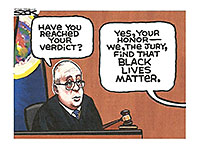
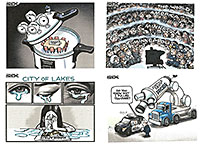
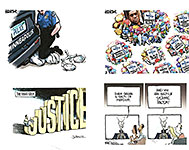
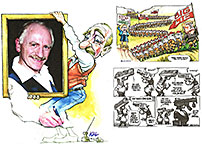
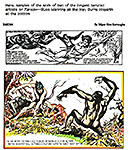
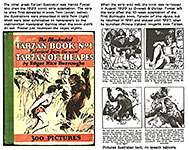
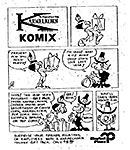

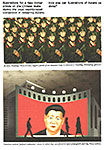
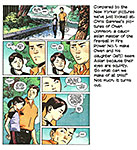
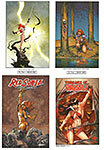
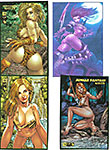
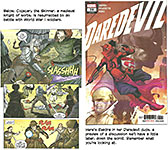
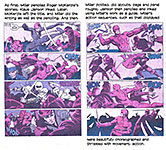
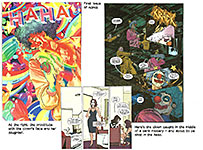
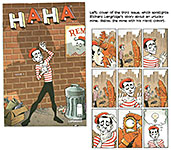
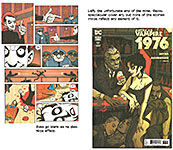
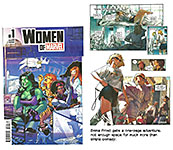
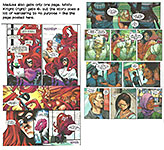
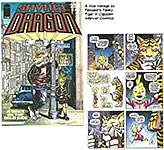

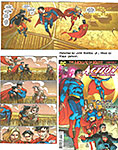

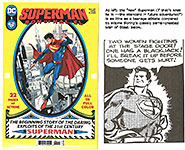
1.jpg)
2.jpg)

